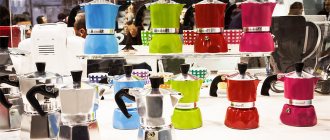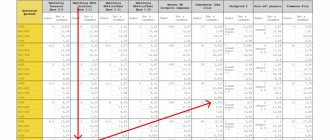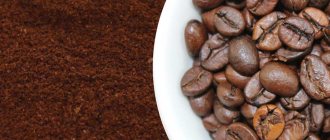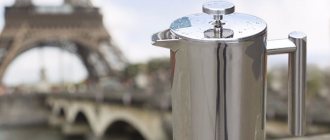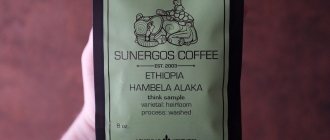Blend vs Single Origin
The concept of SINGLE ORIGIN (single origin) means coffee beans collected from one region, one farm, while BLEND is a mixture of different coffee varieties. The term micro lots is used to refer to special varieties of coffee specially grown within a small farm or on a specific area of a plantation.
MICROLOT is one type of grain, collected from one farm, processed in one way. approx. Editorial staff
The question arises: is such a division necessary for the average coffee drinker? Yes, because the taste of coffee is affected by where and in what conditions it is grown. As we will now see, country, region, farm, processing method, variety of coffee tree and much more affect the taste and aroma of our drink.
SINGLE ORIGIN is a coffee bean collected from one farm, processed in one way and roasted according to one profile. Typically, these are high-quality coffees with unique flavor characteristics that roasters do not want to overshadow or mix with other varieties.
BLEND (coffee blend) is created when a mixture of two coffee varieties gives a better taste than the same two varieties separately and in order to achieve taste stability. Let's say there is a light, fruity Ethiopia, but it lacks a little body. (For example, blends are often used to make espresso)
While SINGLE ORIGIN is generally more prized by specialty drinkers (and costs more) than BLEND, they can both be excellent. There are bad SINGLE ORIGIN and good BLEND, they just have different concepts. Try it and don't give up on coffee just because it's a blend of beans from three countries.
At the same time, immerse yourself in the world of SINGLE ORIGIN by tasting coffee from different regions. Take Guatemala, which is known for its acidity, balance and spicy notes, then compare it to coffee from Rwanda, which is known for its sweetness and full body. And then, try samples from two different regions of Colombia - say, Nariño and Santander. Get to know the origins and characteristics of the coffees you love.
But remember, just because a country tends to have a certain flavor of coffee, doesn't mean all of its coffee will match that flavor. Be open to new discoveries!
BREAKFAST BLEND (ESPRESSO MIXTURE of two varieties of Arabica Brazil Fine Cup + Ethiopia Sidamo) www.coffeeproject.ru
Rating TOP 7 best coffee capsules
The TOP of the best capsule coffees, in our opinion, looks exactly like this:
- Nespresso Arpeggio Decaffeinato.
- Dolce Gusto Cappuccino.
- Tassimo Latte Macchiato Caramel.
- Cremesso Lungo Caramello.
- Nespresso Envivo Lungo.
- Lavazza Intenso.
- Paulig Classic.
Let's look at them separately.
Nespresso Arpeggio Decaffeinato
Capsules made from dark roasted 100% Arabica coffee beans from Central America. It has a rich and dense taste with notes of cocoa. Despite the lack of caffeine, the drink has the best characteristics of a regular strong aromatic drink. Roasting - 4 out of 5, bitterness - 4 out of 5, sourness 2 out of 5. These capsules are perfect for lovers of real high-quality coffee.
| Cup volume | 40 ml |
| Coffee intensity | 9 |
| Quantity | 10 pieces |
Price: from 250 to 440 rubles.
- cafein free;
- rich coffee aroma;
- notes of cocoa in the aftertaste.
- a little bitter.
Wonderful and tasty drink! I'm already buying my third pack. I love strong coffee and drink it without adding milk or sugar. I am a connoisseur of true aroma and taste. These capsules fully satisfy my need for a good cup of coffee in the morning. There are no complaints or comments. Excellent grind, slightly bitter, but within limits. The price justifies the quality. I recommend it from the bottom of my heart!
Nespresso Arpeggio Decaffeinato
Dolce Gusto Cappuccino
Italian coffee with a rich aroma of strong espresso and a delicate creamy taste. Cappuccino from Dolce Gusto is an undoubted example of a classic that will captivate all coffee lovers. Due to the blend of high-quality Arabica beans from South America, the drink has a rich taste. The high-pressure coffee machine produces the perfect Italian cappuccino with velvety foam. One package contains 16 capsules (8 capsules with ground coffee and 8 with milk). Milk capsules contain milk powder, emulsifier and sugar.
Ratings on the topic: Rating of the 7 most popular built-in washing machines
| Coffee intensity | 5 |
| Cup volume | 240 ml |
| Quantity | 8 pcs |
Price: from 280 to 610 rubles.
- dense milk foam;
- rich Arabica aroma;
- creamy taste of the drink.
- few capsules (enough for 8 cups).
Perfect capsules. I didn't notice any cons, the coffee was great. Good and rich taste, bright aroma, density of coffee - everything is perfect. I didn't expect such a delicious cappuccino from a capsule. There are 16 products in the package, but they are enough for 8 mugs (8 capsules with ground coffee and 8 with milk). The foam turns out dense and does not settle. I am pleased. Now I can enjoy cappuccino at any time of the day or night.
Dolce Gusto Cappuccino
Tassimo Latte Macchiato Caramel
A three-layer coffee and milk combination with velvety foam with notes of caramel. Due to the updated recipe with condensed cream, the texture is very airy and creamy. Each package contains 8 capsules with ground coffee and 8 capsules with a dairy product. The latte is prepared at the touch of a button and comes out with a large cup of 285 milliliters.
| Coffee intensity | 5 |
| Quantity | 8 pcs |
| Cup volume | 285 ml |
Price: from 229 to 1045 rubles.
- rich caramel taste;
- the drink is not bitter;
- large volume of drink at the exit (285 ml).
- few capsules (enough for 8 cups).
Only Tassimo capsules are suitable for my coffee machine, fortunately there are many of them on the market! From simple coffee to hot chocolate. I love and respect them for their rich assortment. I like these capsules, I’m buying them for the fourth time. They don't get bored. Pleasant taste and aroma. I usually drink 1 cup a day, but sometimes I feel like drinking a second one. The taste is too rich, you want to enjoy it. If you haven’t tried Tassimo drinks yet, then run to the store and buy them! I recommend it from the bottom of my heart.
Tassimo Latte Macchiato Caramel
Cremesso Lungo Caramello
A composition of selected Arabica beans from Africa gives the drink a harmonious aroma. It is ideal for making longo coffee and latte macchiato due to its roast level and mild aroma. Cremesso coffee varieties are certified according to the UTZ program aimed at achieving high social and environmental standards in production. The drink is safe and does not contain any impurities or harmful elements.
| Cup volume | 110 ml |
| Quantity | 16 pcs |
| Coffee intensity | 2 |
Price: from 469 to 550 rubles.
- soft caramel taste;
- rich coffee aroma;
- UTZ certificate (does not contain impurities or harmful additives).
- difficult to find in stores.
A pleasant and delicate tasting drink with notes of caramel. I often make lattes; these capsules are ideal for similar purposes because they have low intensity and a sweet aftertaste. In general, I love coffee, I try different capsules, but for now I’ve settled on these. They are very easy to use. You press a button and you get a flavorful drink. No need to cook in a Turk, wait a long time. Everyone should have capsule coffee machines at home! I don’t know how I used to live without this wonderful device.
Cremesso Lungo Caramello
Nespresso Envivo Lungo
A stunning blend of Arabica from India and Robusta from Mexico, created for the purpose of making large volume coffee. The drink reveals a dense texture and bright taste. There are sweet woody notes and a caramel flavor.
Adding a little cream will reveal the delicate aroma of gingerbread. Bitterness - 4 out of 5, sourness - 1 out of 5.
| Quantity | 10 pieces |
| Cup volume | 110 ml |
| Coffee intensity | 9 |
Price: from 320 to 470 rubles.
- aroma of caramel and gingerbread;
- rich taste;
- bright coffee aroma.
- There is a slight bitterness in the aftertaste.
I am a coffee maniac and can drink coffee 24 hours a day. Nespresso capsules are incomparable to any other brand. They are unique! Sold in boxes of 10 pieces. I drink 1 cup a day, so I’m completely satisfied with the price. Buying a cafe is much more expensive. I like to try different capsules, but these are my favorite so far.
Nespresso Envivo Lungo
Lavazza Intenso
Lavazza Blue Espresso Intenso coffee capsules are the ideal blend for strong espresso with thick, viscous crema. A blend of Brazilian Arabica and South Asian Robusta creates a magnificent and harmonious taste and aroma of the presented coffee. The capsules are only compatible with Lavazza Blue capsule coffee machines.
Ratings on the topic: TOP 10 best toasters: advantages and disadvantages of the best models, price
| Quantity | 10 pieces |
| Cup volume | 110 ml |
| Coffee intensity | 9 |
Price: from 2900 to 3200 rub.
- bitter chocolate taste;
- rich coffee aroma;
- dense milk foam.
- not found.
Lavazza Intenso is a classic, nothing new or exclusive, but the foam is just perfect. I recommend it to lovers of strong espresso that will wake up even the dead. A mixture of Arabica and Robusta is much more interesting than both of these varieties separately.
Lavazza Intenso
Paulig Classic
In order to create the Paulig Classic coffee blend, the technology of separate roasting of each variety is used; this process makes it possible to maximize their taste characteristics and complex aroma. Espresso made using these coffee capsules contains an aftertaste with notes of truffle chocolate, rum and cinnamon, and the mild strength allows you to enjoy it not only in the morning, but throughout the day. Coffee pods fit the Paulig capsule system (K-fee). Each capsule is designed for one serving of espresso or lungo.
| Quantity | 16 pcs |
| Cup volume | 110 ml |
| Coffee intensity | 5 |
Price: from 480 to 550 rubles.
- composition of 100% Arabica;
- aftertaste with notes of truffle chocolate, rum and cinnamon;
- no bitterness.
- not found.
Fine, classic espresso from elite Arabica varieties. Tasty, strong, rich, aromatic, nothing more is needed. It’s convenient to use capsules; I make sure that I always have a supply at home and at work. The grind is a bit coarse for my liking, but otherwise the coffee is excellent.
Paulig Classic
Roasting degree
There are many different names to determine the type of roast: light, medium, Viennese, City plus, filter, blonde...
You must understand that roasting is a process that unlocks the existing flavor and aroma potential of coffee beans. However, if you roast the grain incorrectly, it will introduce additional unnecessary flavors that will overwhelm the characteristics of the grain. Undercooked grain will be grassy and sour. Over-roasted coffee will taste bitter, smoky, and unpleasant.
Specialty coffee connoisseurs prefer light roasts, but the fact is that the best roast depends on the bean itself, the preparation method and, of course, consumer preferences. Let's see why.
Two packs of single origin coffee: KENYA BARAGWI and GUATEMALA – SAN FLORENCIO, roasted under filter www.aprilcoffeeroasters.com ©Ana Valencia
Light roast
Also known as cinnamon, blonde, City and City Plus - primarily for medium-light roasts.
These profiles are known to highlight fruity and acidic notes in flavor and aroma and are therefore suitable for coffees that already have these characteristics. Some people argue that light roasts are less sweet, but this is not always the case. Because high-quality specialty coffee is prized for its complex profile, many roasters opt for a light or medium-light roast to highlight this.
Dark roast
In other words, Vienna or Light French, while Full French and Italian are considered very dark roasts.
When you drink dark roast coffee, you can taste the roasting process itself—roasty, bitter, and full-bodied. Dark roast has a bad reputation among specialty coffee drinkers and is sometimes used to hide imperfections in the bean.
Range of roast types ©Starbucks
Medium roast
Also known as Full City, the slightly darker-than-medium roast is called Full City Plus.
Why did we put the description about medium roast after light and dark, instead of in the middle? Because a medium roast is largely defined by what it isn't—it's neither light nor dark. Instead, think about balance, body, profile, characteristics that don't overshadow the coffee's natural flavors and aromas.
Espresso, Filter and Omni
espresso roasts are slightly darker than filter . (This is the difference between dark and light roasts.) Omni roasting, in turn, is intended for both filter coffee and espresso.
So why are the roast profiles different for espresso and filter? Because espresso is an intense brewing method well suited for sweet, full-bodied coffee, while filter coffee is generally known for its complexity and uniqueness.
A Brief Introduction to Blends
Coffee for making espresso is almost always a mixture of several varieties of beans (blend). In Italian the mixture is called "miscela". Miscela is one of the four M's of true espresso.
The variety of coffee varieties provides ample opportunities for creating blends. At the same time, the basic rules for creating an espresso blend are as follows: the coffee must have muted acidity, be full-bodied and sweet enough to balance the bitterness and acidity in the taste of the finished drink.
As for single origin or monosorts (coffee of one variety, grown in a single area and in one season), most of them in their pure form are not suitable for making espresso. This is due to the fact that single origin has a “one-sided” taste and does not have the balance and bouquet inherent in blends.
As a rule, espresso blends are made from different varieties of Arabica. However, in some cases, robusta is used. Arabica and Robusta are considered separate species of the coffee tree. Robusta has a higher yield, has larger cultivation areas and is therefore noticeably cheaper than Arabica.
Arabica has a delicate and mild taste. Robusta is coarser, stronger, bitter, “sharp”. It has more caffeine. Robusta is added to blends for fullness of taste, sweetness, but most importantly: it gives a stable crema (coffee foam on the surface of the espresso). At the same time, using robusta can have unpleasant downsides - for example, the smell of burnt rubber.
Although high-grade Robusta does not produce an unpleasant odor, it does drown out other aromas. Therefore, the use of Robusta is considered a controversial issue among coffee experts.
Processing methods
You can read more in our previous article.
Cutaway coffee berry © Nicolas Rozental
Coffee is actually more than just a bean. It is the seed of the coffee berry, commonly called a "cherry" for its round shape and typical (but not always) bright red color when ripe. But removing the sticky fruit layer is not so easy; special equipment for depulping and subsequent fermentation is often used for this. These processes are called coffee processing, and the processing methods also affect the taste of the coffee. That's why it will be indicated on the coffee pack.
Washed or wet processing
The pulp is removed with water, then the grains are dried. This method does not greatly affect the taste of the coffee, which means you can taste the pure, natural taste of the bean.
Dry or natural method
The beans are slowly dried under the sun while still in the coffee cherry. This method is intended to produce a sweet and fruity taste. But if suddenly the drying is done poorly, the coffee may turn out to be of poor quality and unsatisfactory taste. But, as a result of proper drying, the coffee will be very tasty. It is also an environmentally friendly option.
Honey and half-wash method
Coffee cherries are dried with varying amounts of berry pulp on the coffee bean. The more pulp, the more sweetness and body there will be in the taste.
However, the best way to understand the difference in processing methods is to try it. Get washed and naturally processed coffee from the same region or, better yet, the same farm. Feel these differences for yourself in your cup.
coffee COLUMBIA LA LUNA, washed processing of coffee berries, www.coffeeproject.ru
Grain processing methods
Coffee berries collected from plantations can be processed in three ways:
- dry processing (Natural)
- semi-dry processing (Pulped Natural)
- wet processing (Washed or Wet processing)
Most espresso blends consist of beans that have undergone so-called dry (Natural) and semi-dry (Pulped Natural) processing.
Dry processing (Natural) involves drying the grain without first removing the pulp. The grain is cleared of dried pulp at the end of drying. As the coffee bean dries over two to three weeks, it absorbs sugars and other flavor components from the pulp.
Natural processed coffee is distinguished by increased sweetness, bright aroma, and rich taste. The dry processing method is used to prepare most of the harvested coffee from Yemen and Ethiopia. The method is also widely used in Brazil and Indonesia.
Semi-dry processing (Pulped Natural) involves removing the skin from the berries before drying, but leaving the pulp. Coffee processed in this way is full-bodied, with muted acidity, it has a soft, balanced taste and a bright aroma. This grain produces more cream (crema). Pulped Natural is common in Brazil.
Semi-dry processed grain (Pulped Natural)
gives more cream (crema)
Wet processing (Washed or Wet processing) involves the complete removal of the skin and berry pulp before drying the grain. Wet processed coffee is highly acidic and produces bright, clean floral and/or fruity aromas and flavors. To prepare espresso in its pure form, wet-processed coffee is, as a rule, not used (with the exception of bold experimenters). This type of grain is added to expensive blends to enhance the muted flavor of dry processed grains. Blends with wet-processed grains are usually light-colored: dark roasting destroys the flavor of the wet-processed grain.
Variety and grade
You can read more in our previous article.
Not all coffee trees are the same. The type and variety can have a significant impact on the final flavor of the cup, so let's take a look at the common varieties.
Specialty coffee
As a rule, this is Arabica , known for its aroma and delicious taste. Robusta is another common species; it has a stronger taste and contains significantly more caffeine. From time to time you may come across a less common species - Liberica .
Next come the varieties of Arabica : Caturra, Catuai, Typica, Geisha, Pacamara, Maragogipe...and many others. Bourbon tends to be sweet. Geisha typically has a light, tea-like body, a jasmine aroma and a complex, unique flavor.
Once you can feel the impact of processing on the taste of the cup, it's time to start understanding the varieties and varieties. Try washed Bourbon and Caturra from El Salvador. Then compare them to natural Bourbon from Rwanda. The beauty of specialty coffee is that each variety is truly unique. There are so many factors that influence the taste of a cup, and we as consumers can enjoy and appreciate each of them.
Freshly roasted coffee ©Nicolas Rozental
Arabica
Lucaffe Mr.Exclusive
pros
- bright taste and aroma
- bud design
- tonic effect
Minuses
- high price
From 990 ₽
The Italian manufacturer used the best coffee brands from America, Africa and Asia in the blend. High quality beans, medium roast. The smell is pronounced, “coffee”. The taste is rich, with a slight bitterness, notes of chocolate and sweetness in the aftertaste. Suitable for Turks and coffee machines. Disadvantage: high cost.
Broceliande Maragogype Colombie
pros
- low caffeine content
- uniform roasting
- bright aroma
Minuses
- inconvenient packaging
From 440 ₽
Arabica from Colombia with low caffeine content. The coffee beans are large and dark. The degree of roasting is above medium. The brewed drink is thick, with bright bitterness and slight sourness. Fragrant, reminiscent of the best oriental varieties. When brewed, it forms a dense, chocolate-colored foam. The packaging is not intended for long-term storage.
Ambassador Platinum
pros
- informative packaging
- saturation
Minuses
- no gas valve
From 237 ₽
Brazilian product with light roasted beans. The beans are medium in size. Packaging without a gas valve does not provide long-term storage. The drink combines bright sourness, noble bitterness, shaded with a subtle nutty aftertaste. Goes well with milk or cream. Suitable for automatic coffee machines.
Growing height
On some coffee packets you may see information about the altitude at which the coffee was grown, usually measured in meters above sea level.
So why should we care? Because the slower a coffee tree grows, the more time it essentially takes for the berries to become saturated with sugars, which contributes to a sweeter and richer taste of the drink.
When comparing two farms in the same region, the one higher up tends to have better climatic conditions. For this reason, the higher altitude at which coffee trees are grown is an indicator of higher quality coffee. But be careful, don't be fooled. After all, for example, at an altitude of 1100 meters in Brazil it will be cooler than in Ecuador.
You also need to take into account the influence of sea currents, wind, and so on. Take the Galapagos Islands, which are located on the equator at an altitude of only 200 meters above sea level and have a cool local climate that produces delicious coffee.
Growing height is useful information when considered in context. Use this when choosing coffee from one region, but don't write off varieties grown at lower altitudes until you've tried them. He may surprise you.
the packaging indicates the growing altitude of 1750 m above sea level, El Salvador coffee from Las Delicias farm, roasted by Smalltime Roasters ©Smalltime Roasters
Which one to choose for a coffee machine
The choice of grain mix depends on taste preferences and the type of machine in which the coffee will be brewed. They have different operating principles.
Each coffee machine has an instruction manual. Manufacturers indicate in it the types of coffee recommended for the device.
In what form do you use coffee for brewing?
GroundIn capsules
You can experiment and make your own blend of different types of coffee to brew the drink. A significant part of coffee machines are not designed to prepare flavored, caramelized varieties. This may damage the device.
Coffee is used for brewing:
- Ground . Designed for geyser, drip, carob type coffee machines and French presses. They prepare a drink only from freshly ground coffee.
- In capsules . Suitable for all types of devices. The capsule is designed to prepare one serving of an invigorating drink and has a balanced composition. These raw materials are used to brew cappuccino, Americano, lungo and latte.
- In pods . Ground coffee is pressed into tablet form. They are used for pod coffee makers and some carob machines that have an adapter.
Fair Trade, Direct Trade, Rainforest Alliance…
(Fair Trade, Direct Trade, Tropical Alliance)
There are many certifications in the coffee industry, and it can sometimes be difficult to understand what each one means.
First, let's look at the most famous of them: the FAIRTRADE certification system ( Fair Trade ). It means that grain producers (farmers) receive a certain amount in addition to the international price of coffee. However, this does not necessarily mean a living wage.
UTZ certification means that producers are trained in best farming practices to improve the quality and yield of coffee. As a result, farmers receive more income.
DIRECT TRADE certification system (direct trade). This is actually a trade model, not a certification program; however, many roasters who use this model will say that it provides consistency in production. It involves the purchase of grain by roasters directly from farmers. These coffees are typically of exceptional quality, and many roasters work with growers to provide additional feedback and support in improving the quality of the crop.
Typically, roasters pay much more than the international coffee price and often more than UTZ and Fairtrade farmers receive in the commodity market. However, some criticize this trading model, arguing that it is not regulated and can only be a marketing one. Unlike the Fairtrade and UTZ programs, in this case it is difficult to know how much the producer actually received for his crop.
Rainforest Alliance label means that the coffee has been grown in environmentally friendly conditions, minimizing damage to local forests and waterways. Similarly, Bird Friendly Coffee denotes organic coffee that supports the growth and restoration of local forests and, as a result, helps local wildlife thrive.
Arabica/Robusta
Pelican Rouge Distinto
pros
- tonic effect
Minuses
- faint odor
From 790 ₽/per 1 kg
A Dutch product containing 70% Arabica, 30% Robusta. The beans are of good quality, the degree of roasting is closer to strong. The aroma is quite weak. The taste is rich, with a strong bitterness, without sour notes, with a nutty aftertaste. The finished drink is very invigorating due to its high caffeine content. The ideal time to take is morning.
Hausbrandt Espresso, vacuum packed
pros
- fortress
- gas valve
Minuses
- overpriced
From 950 ₽/for 0.5 kg
A blend of coffee beans from Africa and Latin America produced in Italy. The ratio of Robusta and Arabica is 50 to 50, the degree of roasting is medium. The finished drink is strong, invigorating due to the high percentage of caffeine, with a rich coffee aroma. Bitterness, notes of cinnamon, pepper and caramel are clearly visible. The best bean coffee in the review for making espresso in automatic coffee machines.
Caffe Vergnano 1882 Espresso Bar
pros
- vacuum packaging
- dense foam
- fortress
Minuses
- No
From RUB 1,931/per 1 kg
Italian coffee, popular on the Russian market, contains 70% Arabica and 30% Robusta. Packaging with a valve keeps coffee beans fresh for a long time. The roast is above medium, the caffeine content is high, as it should be in espresso. Rich, with pronounced bitterness and bright fruity notes. Some may find it too bright. The smell is strong, “coffee”, characteristic of Turkish brands. The foam is high, very dense, and lasts a long time.
Cup of Excellence, Good Food Award…
On a pack of coffee you can find not only various certifications, but also quality awards.
Cup of Excellence is an award that determines the quality of green beans as presented by the manufacturer. This means that the roast profile is not taken into account at this championship when cupping samples and, in fact, many roastmasters (roasters) can offer their own roast profile.
Many producing countries have their own Cup of Excellence , so you may be able to see which variety has won the Cup of Excellence in Colombia, or you may find that a particular farm has won the Cup of Excellence in Burandii (Burundi Cup of Perfection). Also, some countries have national awards, such as “Best Pacarama” or “Brazilian Coffee of the Year”.
The Good Food award, on the other hand, is awarded in the United States for roasted coffee. In other words, only a specific variety presented by a specific roasting company can become a Good Food Award winner.
There are many more awards for coffee quality. But these two awards, perhaps the most famous and significant, demonstrate the starkest differences between them: one goes to the roasted bean, the other to the unroasted one.
Good Food Award, Ethiopia Ardi coffee roasted by: Huckleberry Roasters ©Huckleberry Roasters
There's so much information contained in a tiny coffee label that it can sometimes make your head spin. But remember, this is all to help you choose the best coffee. So go ahead: take your time! Compare processing methods and grain origins. Ask your barista for more information. Try new things to find out what you like.
Because that's how you learn more about your favorite drink.
Which coffee grind is best for a coffee machine?
After carefully selecting the coffee beans, all that remains is to grind them. You can trust this to your coffee machine. But not all devices have a built-in coffee grinder, and if they do, they handle grinding differently. In addition, coffee beans differ from each other in size and hardness. Therefore, instead of taking risks, coffee lovers grind coffee beans in manual or electric mills. Such preparation not only spares the electrical appliance, but also develops the user's sense of taster (different types of grinding make the coffee taste differently rich).
Coffee grind levels
As for the quality of coffee grinding, it can be:
- Large;
- Average;
- Small;
- Poroshkov.
If the coffee machine is budget, then a medium coffee grind will be optimal for it. In powerful models, you can use coarse grinding. Being stored inside the filter, it can additionally be used for brewing coffee using a French press or coffee pot. It is better to leave fine and powdered coffee to a Turk.
It is always important to adjust the grind while the coffee machine is running so that the fragmentation of the whole coffee can be adjusted. But if you want to avoid settings, then among coffee machines it is better to purchase a pod espresso machine. However, in this case, coffee will have to be purchased in special pods (hygienic tablets), i.e. pre-crushed.
Household appliances Coffee machine
What to look for when choosing coffee beans for a coffee shop
The choice of coffee for any establishment depends on several important factors, which include the concept of the cafe, financial capabilities, menu of the establishment, etc. But there is no direct relationship between the quality of the chosen coffee and the success of the coffee shop.
The easiest way when choosing coffee is to choose the one that suits you in terms of price and quality, and to the taste of your guests. Therefore, you can purchase either a simple product belonging to the category of “rootless coffee” for 400-500 rubles per kilogram, or an elite product, the cost of which can reach up to 10 thousand rubles per kilogram.
If you want to think through everything down to the smallest detail, use these tips:
- The concept of the establishment. If you plan to open a specialty coffee shop, the main visitors of which should be coffee connoisseurs and connoisseurs, get ready for the fact that your menu will include only high-quality drinks. When choosing a simpler commercial coffee option, be sure to indicate this in your establishment's concept so that guests know where they are coming.
- Financial opportunities. Elite coffee is always expensive. When purchasing 1 kilogram of specialty coffee, you will have to spend 1.5-2 thousand rubles. More simply, commercial coffee costs much less. Here you can choose products that will cost between 1.3-1.5 thousand rubles. And if you find a permanent supplier, the price may become even lower over time.
- Staff. Please note that when choosing elite varieties of coffee (specialty), you will have to hire only experienced baristas, since this drink is quite difficult to prepare. Commercial varieties will be able to “survive” the mistakes of beginners, so recruiting staff will be much easier. If you decide not to philosophize and serve your guests simple “rootless” coffee, then you can get by with hiring people with no experience at all.
- Menu. If you want to use an alternative - a method of brewing coffee without a coffee machine, then you are better off choosing the most expensive and elite varieties of the drink, as they are best suited for this option. Even the most inexpensive alternative and specialty varieties perfectly reveal the subtleties of their aroma and taste if you brew them using an alternative method. But simple coffee from a nearby supermarket is unlikely to be suitable for this brewing method. But the inexpensive product can be used for a coffee machine.
It is also worth considering the quality of the milk. If you use inexpensive varieties of coffee, then plain milk or milk purchased at any hypermarket will be enough. But elite varieties require the best milk, otherwise the drink will simply be spoiled. In this case, you will have to prepare for the fact that each new batch of coffee will require the selection of new milk suitable for it.
How to choose ground coffee
The optimal solution if you do not have the opportunity to grind beans at home is to buy ground coffee or ask them to grind the beans at a coffee shop. To understand which ground coffee tastes better, look at the factors we described above: bean type (Arabica or Robusta), roast level, freshness and grind. Ask your barista or check the package to see what preparation the grain is ground for.
Coffee Like has put together a line of coffee beans that are suitable for different brewing methods. For example, we recommend using the single-origin Brazil Cerrado for an espresso machine and geyser coffee maker. This is coffee without excess acidity, aromatic and balanced, with notes of roasted nuts, dark chocolate and caramel. All other single-origin coffees are suitable for filter coffee, and the barista at any Coffee Like coffee bar will introduce you to the flavors, grinding and subtleties of preparation.
Delicious coffee everyone!





